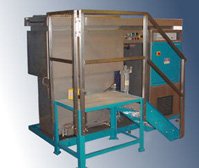
 |
||||||||
Greco Brothers Solvent Vapor Degreasers are designed and built to provide years of trouble-free operation, utilizing virtually any of the non-flammable degreasing solvents currently on the market. Our systems can be configured to operate with chlorinated solvents and n-propyl bromide to remove heavy grease, oils, and compounds from heavily soiled industrial parts; or with the new HFE and HFC blends used in precision cleaning applications. Greco Brothers solvent vapor degreasing systems meet recent EPA and NESHAP guidelines and include innovative features, like sealing covers,automated shut-down cycles, and early malfunction detection:all designed to make operating with the new solvents cost-effective and trouble-free. How Vapor Degreasers WorkSolvent degreasing involves the exposure of a workpiece to pure solvent vapors released by a boiling solvent. The workpiece is usually suspended in the vapors just above the boiling solvent. When the warm vapors touch the comparatively cool workpiece, a condensing action occurs which dissolves the contamination and flushes it away as it runs off the part. This cleaning action will continue until the workpiece and the solvent vapor are the same temperature. Beyond this basic procedure a number of additional cleaning operations are often used, including immersion rinsing, ultrasonic cleaning, spray under immersion, and part agitation. The degreaser styles depicted here can operate with n-propyl bromide, chlorinated solvents, and the new fluorinated solvents like HFE's, HFC's and their azeotropes. Degreasing ApplicationsAlthough water-based cleaning systems are effective in many applications, some aspects of aqueous-based cleaning can make it impractical or unusable for certain cleaning applications. Solvent degreasers are used for removal of petroleum based oil, grease, wax and other stubborn solvent-soluble soils from nearly any non-porous surface. They are also very effective at precision-cleaning highy sensitive parts contaminated with dust, fingerprints, and other air-borne contaminants. Vapor degreasers are commonly used to clean, machined parts, electrical and electronic subassemblies, intricate metal and plastic components, artificial joints, lenses, and a wide variety of other products prior to further processing, assembly, inspection, or packaging. Nearly any part can be cleaned in a solvent degreaser without concern for quality control issues like part oxidation, effective drying, and water spots, because no water is used in the process. Safety Controls & Solvent Retention SystemsAll solvent degreasers depicted here are designed to meet or exceed the latest EPA guidelines for safety and solvent retention. Safety Controls:Every style includes safety interlocks which interrupt the machine's operation if the system runs low on liquid, high on vapor, or if the temperature in the cleaning compartment rises significantly above the boiling point of the solvent. Additionally, power to the spray pump will be interrupted if the vapor level drops by more than four inches.Solvent Retention Systems:One of the prime objectives in degreaser-design is solvent efficiency. Retaining the vapors within the machine is important for worker safety and economic operation. Several factors effect the overall efficiency of the system:The Primary Cooling System:A multiple pass perimeter cooling coil is used as a heat exchanger to condense the vapors, creating a sustainable vapor zone. The primary coil must be maintained at a temperature that will cause the vapors to readily condense. This function can be performed by directly refrigerating the coil, or by passing chilled water through it.
Secondary Cooling System:The secondary cooling system consists of an additional cooling coil that is mounted directly above the primary coooing coil and maintained at sub-zero temperatures, creating a cold blanket of air which further reduces solvent consumption. EPA guidelines call for a freeboard chiller on vapor degreasers containing trichloroethylene, perchloroethylene, or methylene chloride. Given that a properly-designed freeboard chiller will reduce evaporative losses by 30% to 45%, the cost of a freeboard chiller can easily be justified as a solvent-saving measure with a short payback period; regardless of whether the degreasing fluid is a chlorinated solvent or a newly developed fluorinated solvent. Freeboard Ratio:Freeboard is the area within the machine above the vapor zone. The freeboard ratio compares the width of the of the top opening of the machine to the freeboard height (the height of the area above the top of the vapor zone. Higher freeboard ratios have been demonstrated to aid in solvent retention. All standard Greco Brothers Vapor Degreasers include freeboard ratios between 1.0:1 and 1.25:1. Freeboard ratios between 1.25:1 and 1.5:1 are offered to customers using HFE's and HFC's if ceiling height at the installation site permits. Drop-Seal Cover:Unlike common sliding covers that leave gaps around their perimeter, this unique cover is designed to roll into place and seal the work chamber from the atmosphere; virtually eliminating evaporative losses during downtime. Our mobile site is still being developed. For more detail, please visit our desktop site.
|
||||||||
|
